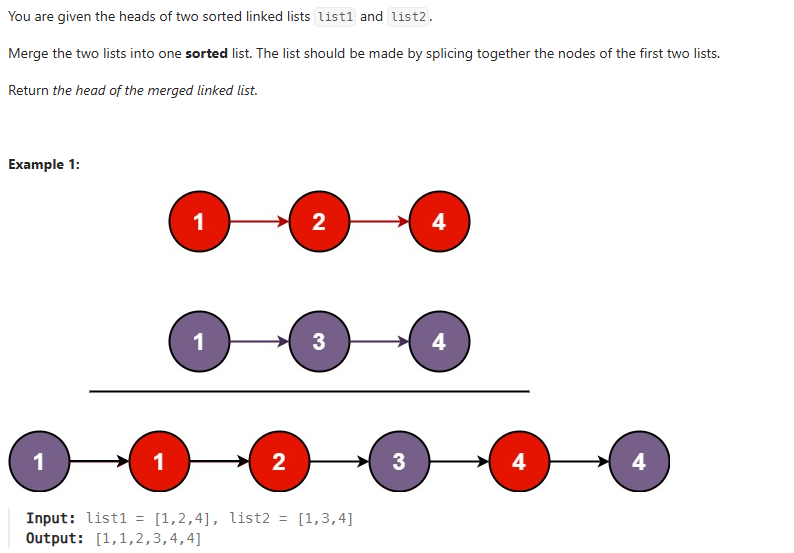今天是紀錄LeetCode解題的第二十一天
第二十一題題目:
給定兩個已排序的鏈結串列list1和list2,合併兩個鏈結串列
解題思路
建立dummy節點當作虛擬開頭,用一個指針current指向dummy,當list1和list2都不為空時,比較兩個的val,current.next指向較小的值,接著把current和被選中的list移向下一個指針,當其中一個list為空時,current直接指向另一個list,最後回傳dummy.next(真正的鏈結串列的頭real head of the merged linked list)
程式碼
class Solution:
def mergeTwoLists(self, list1: Optional[ListNode], list2: Optional[ListNode]) -> Optional[ListNode]:
dummy = ListNode(0)
current = dummy
while list1 and list2:
if list1.val < list2.val:
current.next = list1
list1 = list1.next
else:
current.next = list2
list2 = list2.next
current = current.next
current.next = list1 if list1 else list2
return dummy.next
執行過程
初始狀態
- dummy → None
- current → dummy
- list1:1 → 2 → 4
- list2:1 → 3 → 4
第一次執行
- list1.val < list2.val → 1 < 1 → False
- 執行:
current.next = list2 #dummy.next -> 1 (list2)
list2 = list2.next #list2 -> 3->4
current = current.next #current -> 1 (list2)
- 狀態:
dummy -> 1 -> None
current -> 1
list1: 1 -> 2 -> 4
list2: 3 -> 4
第二次執行
- list1.val < list2.val → 1 < 3 → True
- 執行:
current.next = list1 #1(list2).next -> 1(list1)
list1 = list1.next #list1 -> 2->4
current = current.next #current -> 1(list1)
- 狀態:
dummy -> 1 -> 1 -> None
current -> 1 (list1)
list1: 2 -> 4
list2: 3 -> 4
第三次執行
- list1.val < list2.val → 2 < 3 → True
- 執行:
current.next = list1 #1(list1).next -> 2
list1 = list1.next #list1 -> 4
current = current.next #current -> 2
- 狀態:
dummy -> 1 -> 1 -> 2 -> None
current -> 2
list1: 4
list2: 3 -> 4
第四次執行
- list1.val < list2.val → 4 < 3 → False
- 執行:
current.next = list2 #2.next -> 3
list2 = list2.next #list2 -> 4
current = current.next #current -> 3
- 狀態:
dummy -> 1 -> 1 -> 2 -> 3 -> None
current -> 3
list1: 4
list2: 4
第五次執行
- list1.val < list2.val → 4 < 4 → False
- 執行:
current.next = list2 #3.next -> 4
list2 = list2.next #list2 -> None
current = current.next #current -> 4
- 狀態:
dummy -> 1 -> 1 -> 2 -> 3 -> 4 -> None
current -> 4
list1: 4
list2: None
最後跳出迴圈,接上剩餘的list1
- current.next = list1 # 4.next -> 4
- 最終鏈結串列:dummy -> 1 -> 1 -> 2 -> 3 -> 4 -> 4
- return dummy.next:1 -> 1 -> 2 -> 3 -> 4 -> 4
核心觀念:current與dummy都是指向同一條鏈表的「節點」
- dummy是鏈表的「起點」
- current是我們用來遍歷和修改鏈表的指標
- 現在兩個變數都指向同一個節點(dummy節點)
- 重要:鏈表是物件(reference type),所以我們改current.next,實際上改的是dummy.next的內容。


 iThome鐵人賽
iThome鐵人賽
 看影片追技術
看更多
看影片追技術
看更多